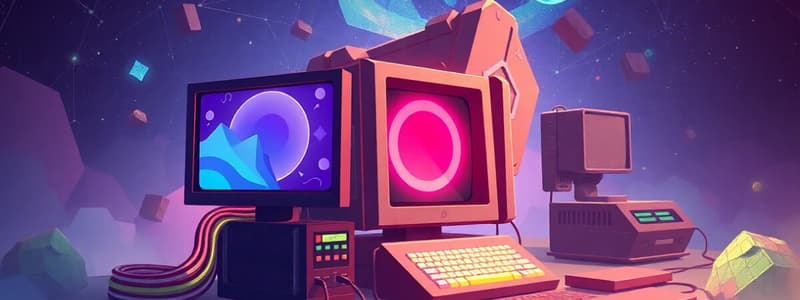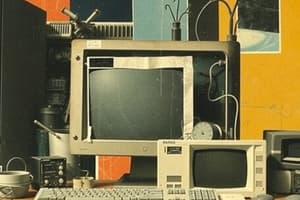Podcast
Questions and Answers
What is a computer system?
What is a computer system?
A group of devices (hardware, software, and liveware) intended to manage, process, receive, and display data in an understandable way.
What are the three main components of a computer system?
What are the three main components of a computer system?
Hardware, software, and liveware.
What is computer hardware?
What is computer hardware?
A computer's tangible and intangible components.
What are the two types of computer software?
What are the two types of computer software?
What is liveware?
What is liveware?
What are the tangible components of a computer that facilitate key operations such as input, processing, output, storage, and communication?
What are the tangible components of a computer that facilitate key operations such as input, processing, output, storage, and communication?
Which of the following is NOT a hardware component of a computer?
Which of the following is NOT a hardware component of a computer?
What is the purpose of the CPU?
What is the purpose of the CPU?
What is the purpose of RAM?
What is the purpose of RAM?
What is the purpose of Input/Output devices?
What is the purpose of Input/Output devices?
What is the purpose of storage devices?
What is the purpose of storage devices?
What is the role of the motherboard?
What is the role of the motherboard?
What is the function of the power supply?
What is the function of the power supply?
Why do computers need cooling systems?
Why do computers need cooling systems?
What does the NIC (Network Interface Card) do?
What does the NIC (Network Interface Card) do?
What are peripherals?
What are peripherals?
What is the role of an operating system?
What is the role of an operating system?
What are applications?
What are applications?
What is the function of drivers?
What is the function of drivers?
What is the primary function of the processor?
What is the primary function of the processor?
The processor has a large amount of memory.
The processor has a large amount of memory.
What are the two fundamental types of memory?
What are the two fundamental types of memory?
What is another name for main memory?
What is another name for main memory?
Main memory is sometimes called volatile because it loses its information when power is removed.
Main memory is sometimes called volatile because it loses its information when power is removed.
Main memory stores programs and data that the processor is actively working with.
Main memory stores programs and data that the processor is actively working with.
Main memory requires constant electric power to keep its information.
Main memory requires constant electric power to keep its information.
What is the primary purpose of secondary memory?
What is the primary purpose of secondary memory?
What are other names for secondary memory?
What are other names for secondary memory?
Secondary memory is only used for storing programs.
Secondary memory is only used for storing programs.
Data stored in secondary memory is easily changed but changes are relatively slow compared to main memory.
Data stored in secondary memory is easily changed but changes are relatively slow compared to main memory.
Secondary memory requires a continuous electric power supply to keep its information.
Secondary memory requires a continuous electric power supply to keep its information.
What is a computer network?
What is a computer network?
What is the difference between a Local Area Network (LAN) and a Wide Area Network (WAN)?
What is the difference between a Local Area Network (LAN) and a Wide Area Network (WAN)?
A Wide Area Network (WAN) can connect thousands of computers together over great distances.
A Wide Area Network (WAN) can connect thousands of computers together over great distances.
What is the purpose of Internet protocols?
What is the purpose of Internet protocols?
What is the function of the TCP/IP protocol?
What is the function of the TCP/IP protocol?
What is the function of FTP?
What is the function of FTP?
What does HTTP do?
What does HTTP do?
Flashcards
Computer System
Computer System
A group of devices (hardware, software, and people) designed to manage, process, receive, and display data.
Computer Hardware
Computer Hardware
The physical components of a computer system.
Computer Software
Computer Software
Programs and apps that run on a computer.
Liveware
Liveware
Signup and view all the flashcards
CPU
CPU
Signup and view all the flashcards
Memory (RAM)
Memory (RAM)
Signup and view all the flashcards
Input/Output Devices
Input/Output Devices
Signup and view all the flashcards
Storage Devices
Storage Devices
Signup and view all the flashcards
Motherboard
Motherboard
Signup and view all the flashcards
Power Supply
Power Supply
Signup and view all the flashcards
Cooling System
Cooling System
Signup and view all the flashcards
Network Interface Card (NIC)
Network Interface Card (NIC)
Signup and view all the flashcards
Peripherals
Peripherals
Signup and view all the flashcards
Operating System (OS)
Operating System (OS)
Signup and view all the flashcards
Applications
Applications
Signup and view all the flashcards
Drivers
Drivers
Signup and view all the flashcards
Main Memory
Main Memory
Signup and view all the flashcards
Secondary Memory
Secondary Memory
Signup and view all the flashcards
Computer Network
Computer Network
Signup and view all the flashcards
Study Notes
Introduction to Computing
- A computer system is a group of devices (hardware, software, and liveware) designed to manage, process, receive and display data in a clear way.
- Hardware includes tangible and intangible computer components that facilitate input, processing, output, secondary storage, and communication.
- Software is also referred to as programs or apps, divided into system software and application software.
- Liveware, also called humanware or orgware, is the person who uses the computer.
Hardware Categories
- A computer system comprises interconnected devices that handle input, output, processing and storage of data.
- Input, processing, storage, output, and communication devices are the five main components of computer hardware.
Hardware Components
- Central Processing Unit (CPU): The CPU is the "brain" of the computer, performing calculations and commands.
- Memory (RAM): RAM is temporary storage for information and commands needed by the CPU for quick access.
- Input/Output Devices: These devices allow data input and instruction entry into the computer.
- Storage Devices: Hard drives and solid-state drives provide long-term data storage, enabling data retrieval even without power.
- Motherboard: This component connects and facilitates communication between computer parts.
- Power Supply: Delivers power to all computer components.
- Cooling systems: Computers use fans or liquid cooling to prevent overheating and potential hardware damage.
- Network Interface Card (NIC): Hardware enabling computer connection to a network and communication with other networked devices.
- Peripherals: These are extra devices (e.g., external hard drives, printers, scanners) that enhance computer functionality.
Software Components
- Operating System (OS): Manages computer hardware and software resources, including storage, memory, and input/output devices.
- Applications: Specific tools (e.g., word processors, browsers, video games) used to perform tasks.
- Drivers: Special software that allows the operating system to interact with hardware components.
Memory
- The processor performs fundamental computer system calculations. Other components assist by storing and moving data in and out of the processor.
- Processor chips have limited memory (RAM) for a few program instructions and the data they process. Complete programs and data are stored in external memory.
- Types of external memory include main (RAM/primary) and secondary (long-term storage).
Main Memory
- Main memory is sometimes called volatile storage as it loses information when power is removed.
- Main memory is closely connected to the processor.
- Data in main memory can be quickly and easily changed, holding programs and data the processor actively uses.
- Main memory requires constant power to retain information.
Secondary Memory
- Secondary memory (e.g., hard drives, solid-state drives) stores programs and data long-term.
- Secondary storage also is called mass storage.
- Data in secondary memory is easily changed but slower than main memory.
- Secondary memory does not need constant power.
Networks
- A computer network connects two or more computers to exchange data and programs.
- Local Area Networks (LANs): Connect a few dozen computers within the same building.
- Wide Area Networks (WANs): Connect thousands of computers over long distances via optical fiber, telephone lines, microwave radio, or satellite communication.
Internet Protocols
- Internet protocols are rules enabling computers and devices to communicate over the internet.
- Protocols ensure correct sending, receiving and understanding of data between systems.
- Examples include TCP/IP (assigns unique IP addresses), SMTP (email), FTP (file transfer), and HTTP (hypertext transfer).
Studying That Suits You
Use AI to generate personalized quizzes and flashcards to suit your learning preferences.




